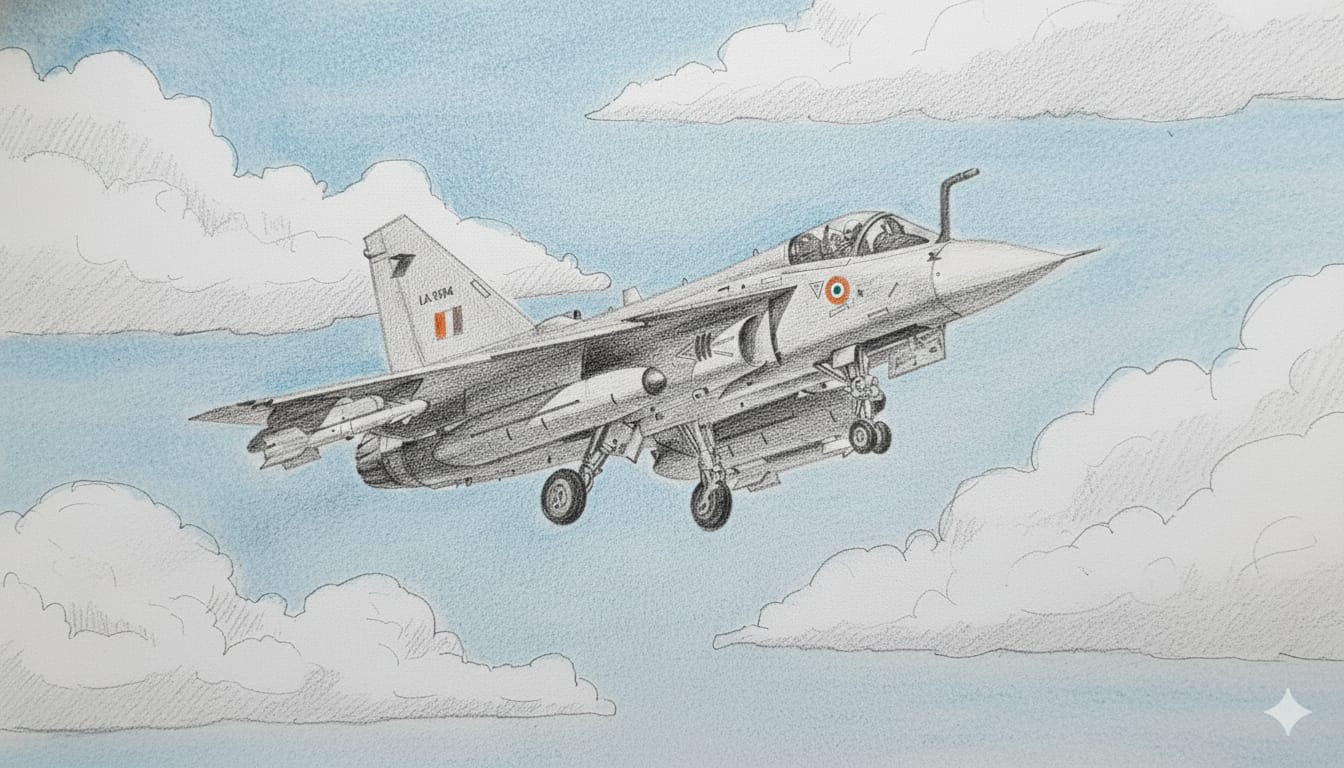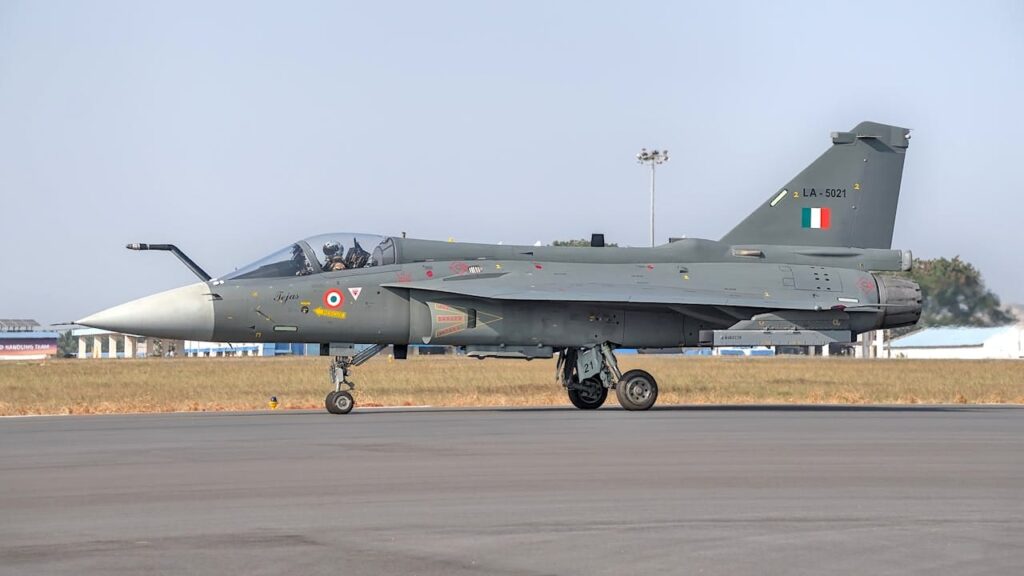
The recent Tejas crash during the Dubai Air show has been a huge setback for our fledgling aero industry and our efforts at indigenisation in this crucial dimension of modern day warfare. Air shows world over are technology demonstration arenas, where global powers showcase their wares and obviously the best of the systems are put on display. This was by no means a maiden effort by Tejas, as it has already participated in a number of air shows and even joint international exercises. In fact two squadrons have even been deployed for operations. Both the variants of Tejas, Mk 1 and Mk1A were deployed in OP SINDOOR . It was formally named Tejas in 2003 and the name may have been derived from the verse,
“Om Namah Shivaya Gurave Sacchidananda-Murtaye
Nisprapancaya Santaya Niralambaya Tejase”
which means, ‘We respect Shiva who is the supreme guide and who is the embodiment of truth, tranquility and bliss. He is independent, full of peace and is full of spiritual light known as tejas’. Like Shiva, it is capable of inflicting destruction in the adversaries camps at cosmic levels.
It is a 4.5 generation, delta wing, multi role combat aircraft which has been designed by Aeronautical Design Agency and manufactured by Hindustan Aeronautics Limited. A 4.5 generation differs from the fifth generation fighter as it does not have stealth capability. Stealth essentially implies near invisibility to radars. So barring stealth, Tejas is a highly advanced fighter jet and although it has been more than four decades in making, it has come of age now. Recently with MIG 21s having been phased out finally, Tejas will be the main stay of the IAF inventory.
We have the expertise to go to the moon or even Mars, build aircraft carriers, nuclear submarines, but when it comes to these lean mean fighting machines, the supersonic jets, we are still struggling. Before I go in to the reasons for this huge void in our military capability, a word about the loss of the precious life of the pilot Wing Commander Namansh Syal, our heart goes out to the bereaved family whose son had made them proud by turning into an ace test pilot, a rare distinction bestowed upon the best in business. While the inquiry committee will no doubt unearth the reasons for this unfortunate crash, one thing is certain, the pilot ensured that he lived upto the Chetwodian motto of ‘his own personal safety being the last priority’ and prevented any collateral damage, but in the process laid down his own life. This also reminds me of the Urdu couplet, “Girte hain Shahsawar hi maidan-e- jang mein, Vo tifl kya gire jo ghutno ke bal chale” meaning it is only the brave and valorous fighters who fall, lesser mortals obviously don’t.
The reasons for any crash is either failure of the systems themselves, sabotage, or may even be a result of electronic or cyber warfare or, sometimes even pilot error. The aircraft is powered by GE Aerospace F404-IN20 engine, which is the heart of the system itself. This dependence creates a huge vulnerability and exposes our failure at not being able to develop this critical component ourselves. Isn’t it ironic that we have successfully developed and deployed cryogenic engines when we were denied these post Pokharan II in 1998 due to sanctions imposed by the US. But Kaveri engine which was designed for combat aircrafts has not been a successful venture and has taken a back seat with our reliance on the GE engines. Technology denial is the most potent weapon which the world powers have been exploiting over the years. We are acutely aware of the Chinese propensity of installing backdoor malware in their systems, providing them with not only intelligence but also the kill switch to render the systems ineffective when most needed remotely. In modern warfare, these acts are not unheard of and will be used extensively, as PM Modi has been stressing, we have no other option but to rely on just one mantra, “atmanirbharta” or self reliance.
While Tejas will continue to surge the skies and blaze a trail of glory in years to come, we as a nation need to develop our own indigenous engines, then and only then, can we keep our adversaries at bay.


13 thoughts on “TEJAS:CALL FOR TOTAL INDIGENISATION”
I AGREE ATMA NIRBHARTA WILL KEY TO OUR GLOBAL AMBITIONS
Om Shanti for Wg. Cdr. Namansh Syal.
This was a very informative read Brig. Suyash.
I hope we as a nation keep our focus on making Tejas 100% indigenous and the best aircraft in its own generation.
Om Shanti Wg. Cdr. Namansh Syal.
Suyash has deliberated quite well on the need of Atmanirbhar Bharat.
Hope the ambition is fulfilled soon!
This cry for indigenous has been ongoing for long. MBT Arjun is an earlier example. This saga seems endless
Dear Sir,
Your article masterfully intertwines the tragic loss of Wing Commander Namansh Syal with the broader narrative of India’s quest for aerospace self‑reliance, highlighting the Tejas’ technical merits and its symbolic resonance with the ancient concept of “Tejas”. You contextualize the aircraft’s 4.5‑generation capabilities while underscoring the strategic vulnerability of relying on foreign engines.
The comparison to the Kaveri engine saga and the geopolitical backdrop of technology denial adds depth, while your poetic invocation of the Urdu couplet enriches the emotional texture. Ultimately, your call for indigenous propulsion reflects a pragmatic vision that could transform India’s defense posture and honor the sacrifice of its brave pilots.
Your eloquent tribute not only honors a fallen hero but also galvanizes a national conversation on self‑sufficiency; the blend of technical insight, cultural references, and heartfelt prose makes your piece both inspiring and compelling, showcasing your talent as a thoughtful chronicler of India’s aerospace journey for future generations to cherish.
With Warm Regards..
GOOD ANALYSIS, RECOMMENDATIONS AND OTHER ASPECTS COVERED LOGICALLY. KEEP WRITING . COL DHIRAJ SHAH
I have a different take on this. India must be Self reliant not in the making of a tank or LCA. Till we master metallurgy, engine technology and OS software we will continue to depend on TOT and slavery. I remember being part of Arjun tank trials in 1988. The engine still is missing the MII tag. Then, very recently I went to Tata in Pune. Went to their truck mfr setup n myself read made in USA written on the truck engine assembly line.
While the current variant of
the MII model is inspiring to look inward, we have miles to go before we actually have niche RnD and Technologies. I am sure soon we will be there too.
Tragic loss. Om Shanti.
I guess we will take a step bck to review and ten surge ahead again
Tragic loss,hope this works as a reminder to the DRDO HAL to get into a mission mode and develop critical technologies. Self reliance is the magic wand for becoming a developed nation.
Insightful.
Two factors. Safety snd Security. Atmanirbharta by itself does not solve both. Security significantly, Safety not as much. Same rigor applies irrespective of country of origin. Just two annas of thoughts….
👍
Well written Suyash !! While going along with this I would suggest digging into the story of Kaveri Gas Turbine. Need for indigenous GT was felt way back in late 50s and in 1961 Gas Turbine Research Establishment was setup in Bengaluru. If you visit GTRE you will see a plush establishment, green campus, excellent design centres, test facilities and beautiful houses for brilliant scientists. Generations of scientists started their career in GTRE earned doctorates become super specialists and retired but could not give GT required for Tejas.
Therefore we had to initially think of RR GTs then go for GE not by choice but out of compulsion. Failure of this massive investment became apparent to the Government in early 2000 and Government wanted to fold up GTRE. Thats when GTRE reached out to Navy with a promise of providing marine gas turbine. And that’s when ‘Kaveri Marine Gas Turbine (KMGT)’ was conceived. GTRE got some funding from Navy in exchange of two billets for Commodore and Commander in GTRE. With Dr Kalam being President of life GTRE got saved from getting wrapped up.
This was the time I was associated with the project for the Marine GT controls. I got a first hand feel of ever sedentary GTRE. Not to waste words in elaborating my specific experiences, I found interaction with GTRE highly frustrating. They would neither understand the huge difference between an Air Craft GT Control System and Marine GT Control System nor would they listen to us. For them men in uniform were inferior brains as they themselves were utilising the service officers posted with them on sundry activities like upkeep of establishment and running club. To make them understand marine GT and controls they were put on SNF destroyer in Vizag for a day. Sea was choppy that day and only thing those scientist could do was to puke and keep puking. Needless to say that they starting fading out of the programme.
Years later after I had joined industry, we happened to meet their top boss at Aero India. He had toned down his temperament as their failures could not be covered up any more. He was talking to my Director seeking industry investment in becoming design and production partner. Outcome of that meeting need not be described here because they could not fool any one any more.
If there is a CAG report on how much tax payers money has gone to GTRE since 1961 it would make all the scandals in history independent India seem like minnows. Kaveri is a colossal failure and biggest setback in LCA programme.
Very well articulated. Hope DRDO, HAL, and all other associated R&D and scientists fraternity living off as highly paid Central Govt employees are taken to task with strict timelines, enough of their enjoying the unaccountability on non-deliverance for more than half a century now.